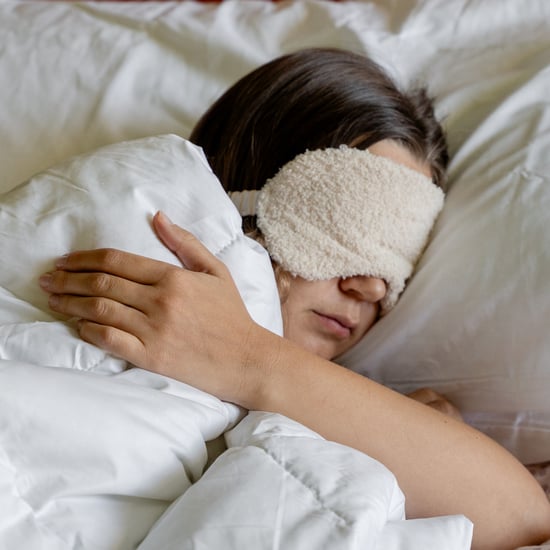How to Lucid Dream
Ever Wondered About Lucid Dreaming? Experts Explain the Risks and Benefits and How to Do It

Call it the Inception effect, but lucid dreaming has become somewhat of a phenomenon in recent years, with both the scientific community and everyday people becoming curious about how to achieve this state of altered consciousness. "Usually, when we dream, we cannot tell the difference between dreams and reality," Nikola Djordjevic MD, a general practitioner and medical advisor at Whatasleep, told POPSUGAR. "However, during a lucid dream, we're aware we're dreaming and often can control our dreams."
It's estimated that half the population has experienced at least one lucid dream in their lifetime, and 11 percent report experiencing two or more lucid dreams every month. Research suggests that lucid dreaming is more prominent among some segments of the population, often linked with personality traits such as openness and self-reflectiveness. But how and when does lucid dreaming occur? Can you induce a lucid dream, and should you even want to? POPSUGAR asked the experts.
What Is Lucid Dreaming Like, and When Does It Happen?
In simple terms, lucid dreaming can feel like a "virtual reality" experience, Alex Dimitriu, MD, a double board-certified physician in psychiatry and sleep medicine and founder of Menlo Park Psychiatry & Sleep Medicine, told POPSUGAR. People who experience lucid dreaming can "control the content and interact with the dream, whereas the rest of us often watch dreams passively, like an immersive movie," Dr. Dimitriu said.
Dreams primarily occur during rapid eye movement sleep (or REM sleep), Dr. Djordjevic explained. The more you get of this deep, restorative sleep, the more likely you are to have a lucid dream. Dr. Dimitriu recommends practicing good sleep hygiene and setting regular sleep and wake times in order to optimise your sleep.
What Are the Benefits and Risks of Lucid Dreaming?
Dr. Djordjevic explained that there are a number of potential benefits of lucid dreaming. Research suggests that lucid dreaming may reduce symptoms of insomnia, anxiety, and depression, by alleviating distressing dreams that can disrupt sleep and affect mood. People who frequently have lucid dreams also score higher in creativity and may have better problem-solving skills, among other characteristics.
By nature, lucid dreaming may also help people overcome chronic nightmares, explained Allison Siebern, PhD, head sleep science advisor at sleep wellness company Proper. "There is a therapy called imagery rehearsal therapy where someone rescripts the nightmares and reads it over before bedtime to assist with altering the dream," Dr. Siebern told POPSUGAR. "One can put cues or symbols in the script so when seen in the dream, it can cue the dreamer that they are dreaming, leading to lucid dreaming."
However, Dr. Djordjevic noted that there can also be risks to lucid dreaming. Some of the methods used to induce lucid dreaming have been linked with poor sleep quality and disrupted sleep. He added that lucid dreams themselves can wear people out, causing them to feel tired even after a full night's sleep. Because of the indistinct boundaries between sleeping and waking, lucid dreaming can also cause confusion, especially for people with mental health disorders. This can lead to dissociative symptoms. So, before you try to tap into any benefits associated with lucid dreaming, it's wise to consult your doctor.
How Can I Lucid Dream?
"The key to achieving lucid dreaming is developing awareness of the dream state as it occurs," Dr. Dimitriu said. He explained that any waking activity that bridges the gap between sleep and reality can reinforce dream recall and increase a person's chances of lucid dreaming.
Two specific techniques researchers have used to induce lucid dreaming are mnemonic induction of lucid dreams (MILD) and wake back to bed (WBTB). In MILD, "the dreamer has a scripted dream which includes symbols that they incorporate into the dream to trigger the realisation [that they're] dreaming," Dr. Siebern explained. Meanwhile, WBTB involves "awakening oneself when REM is most likely happening to stay awake for a few minutes, and then falling back into sleep and potentially back into REM sleep and a dream." Dr. Siebern gave an example of waking up to an early morning alarm clock, falling back asleep, and then dreaming about the alarm going off.
Keeping a dream journal can also be very helpful. Dream journals help to prime the dream ahead of time, Dr. Siebern explained. In the journal, you can write a script for what you want to dream about, inserting symbols so that when you see them in the dream, you're reminded that you're dreaming. "Reading the dream journal before bed can help set the stage for the dream life," she said.
Another method is reality testing. Reality testing is when people train their minds to notice their own awareness and how that maps with reality, Dr. Siebern told POPSUGAR. "By checking in and doing a reality check during the day, it can then be practiced in sleep to help the dreamer distinguish reality from dreaming so there becomes an awareness that the person is dreaming," she said.
Lastly, meditation can be useful for inducing lucid dreaming. "Mindfulness cultivates more self awareness," Dr. Siebern said. She explained that self-awareness can carry into the dream state, making it easier for a person to know the difference between fantasy and reality.






